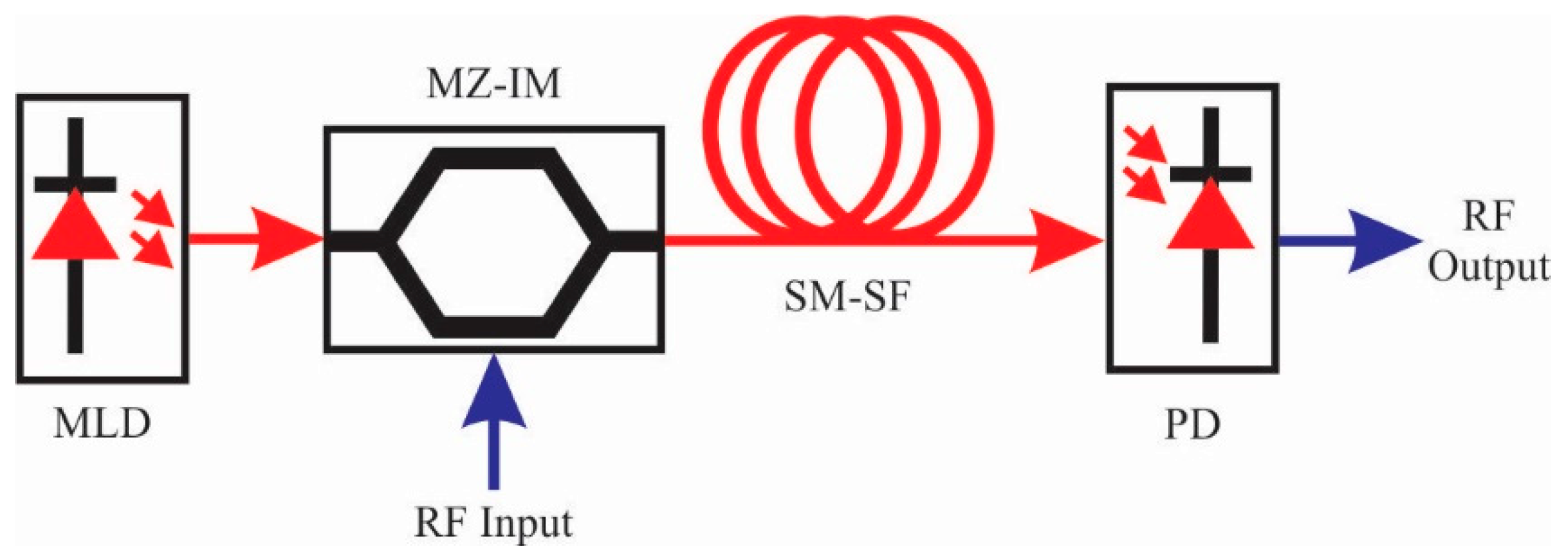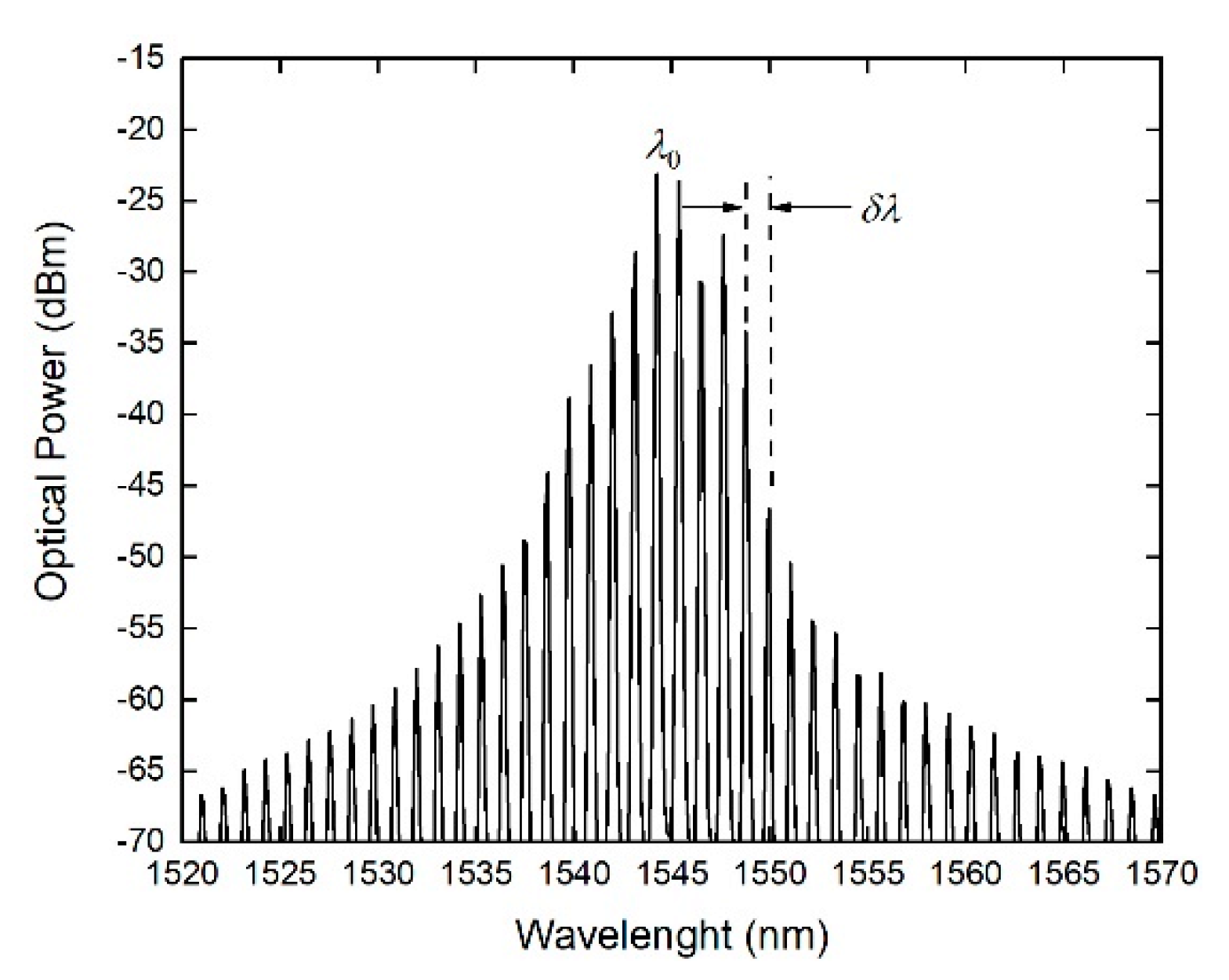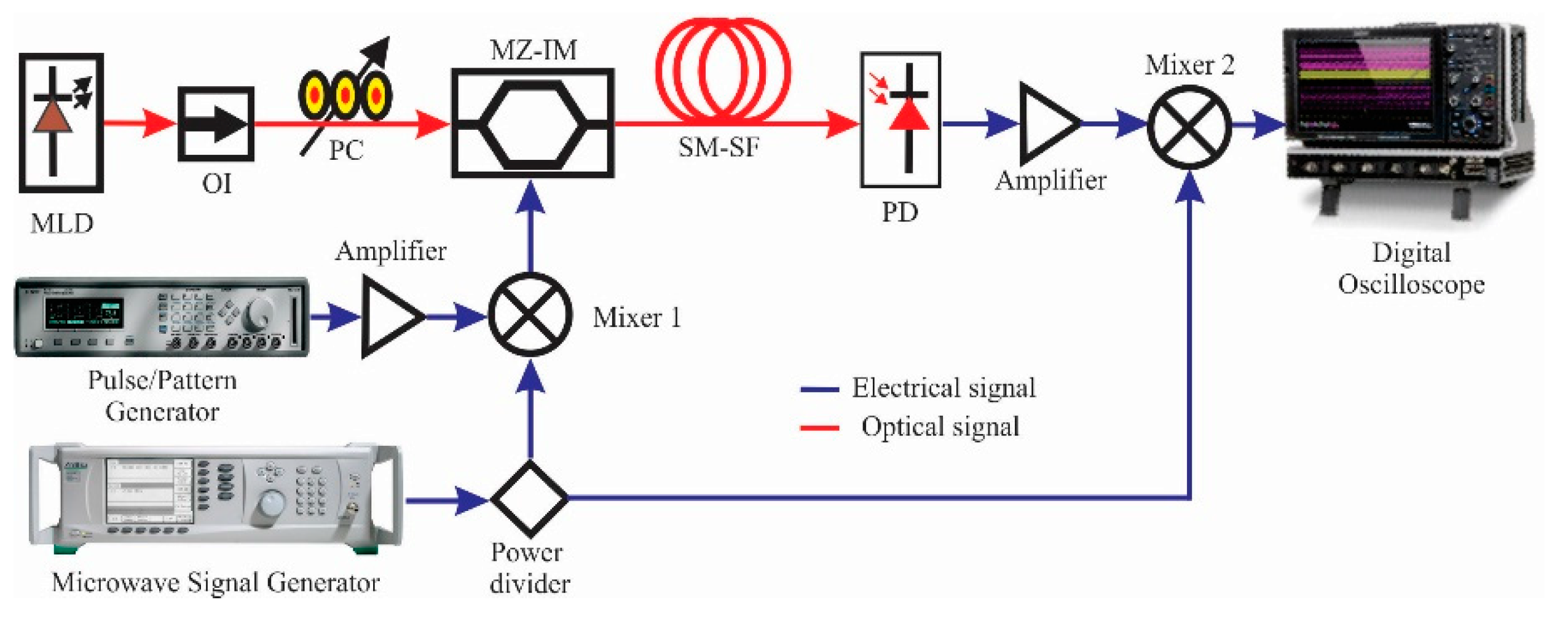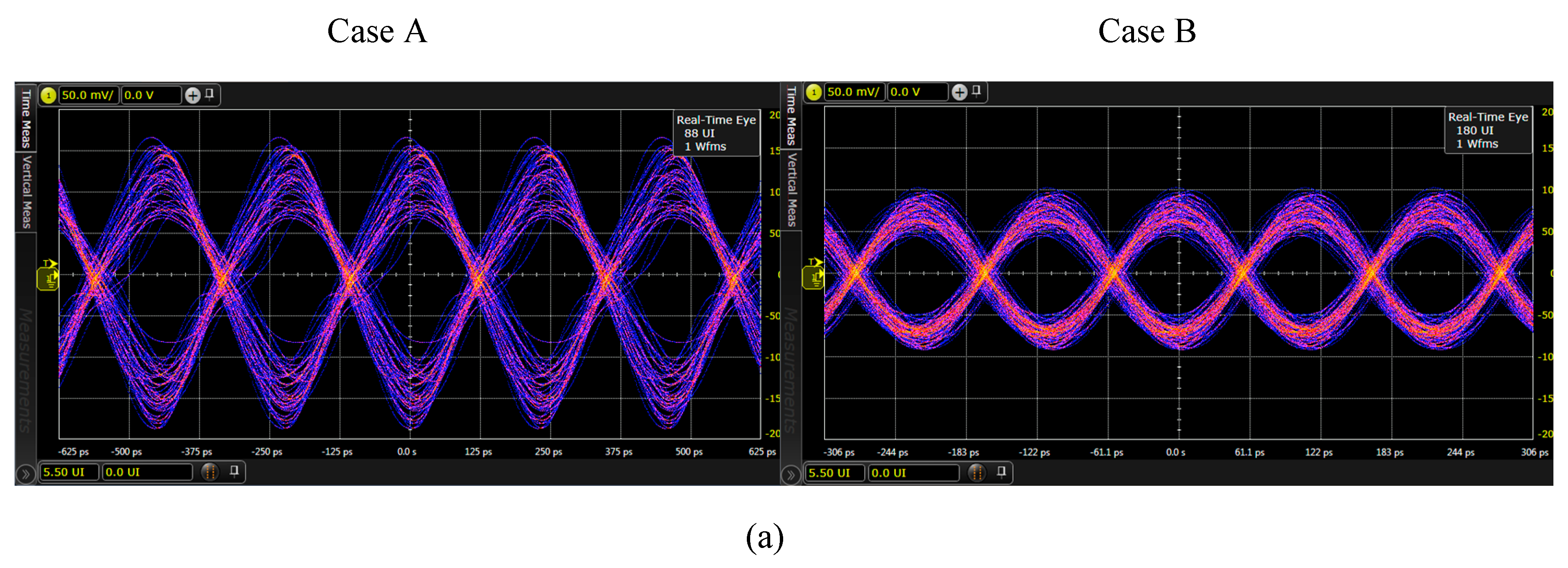Experimental Transmission of Digital Data Coded on Electrical Carriers at 2.1 GHz and 4.2 GHz by Using a Microwave Photonic Filter
Abstract
1. Introduction
2. Basic Principle, Experimental Setup and Results
2.1. The MPF Principle of Operation
2.2. Experimental Description
2.2.1. Experimental MPF Frequency Response
2.2.2. Experimental Digital Signals Transmission
3. Conclusions
Author Contributions
Funding
Acknowledgments
Conflicts of Interest
References
- Tomasi, W. Advanced Electronic Communications Systems, 6th ed.; Pearson: London, UK, 2014. [Google Scholar]
- Winzer, P.; Essiambre, R. Optical Fiber Telecommunications V B, 5th ed.; Academic Press: Holmdel, NJ, USA, 2008. [Google Scholar] [CrossRef]
- Li, L.; Yi, X.; Song, S.; Chew, S.X.; Minasian, R.; Nguyen, L. Microwave Photonic Signal Processing and Sensing Based on Optical Filtering. Appl. Sci. 2019, 9, 163–165. [Google Scholar] [CrossRef]
- Alobaidan, H. Current and Future FTTH Technologies. J. Wirel. Netw. Commun. 2017, 7, 35–40. [Google Scholar] [CrossRef]
- Ali, R.; Ali, M.; Mir, T.; Shabir, B.; Lilla, U. Analytical Review of Advance Optical Modulation Formats. ELELIJ 2015, 4, 35. [Google Scholar] [CrossRef]
- García-Pérez, A.; Andrade-Lucio, J.; Ibarra-Manzano, O.; Alvarado-Méndez, E.; Trejo-Duran, M.; Gutiérrez-Martín, H. Efficient modulation formats for high bit-rate fiber transmission. Acta Univ. 2006, 16, 17–26. [Google Scholar]
- Irfan, M.; Qureshi, M.; Zafar, S. Evaluation of advanced modulation formats using triple-play services in GPON based FTTH. In Proceedings of the International Conference on in Cloud Computing, Riyadh, Saudi Arabia, 26–29 April 2015; pp. 1–6. [Google Scholar] [CrossRef]
- Phogat, A.; Gulati, T.; Malik, D. Q-factor and Jitter performance in WDM systems using RZ, NRZ, and Duobinary modulation formats at different distances. Int. J. Latest Trends Eng. Technol. 2013, 2, 30–34. [Google Scholar]
- Kurbatska, I.; Alsevska, A.; Gegere, L.; Bobrovs, V. Comparison of modulation formats for use in the next generation passive optical networks. In Proceedings of the Progress in Electromagnetic Research Symposium, Shanghai, China, 8–11 August 2016; pp. 3783–3787. [Google Scholar] [CrossRef]
- González-Mondragón, L.A.; Quintero-Rodríguez, L.J.; García-Juárez, A.; Vera-Marquina, A.; Zaldívar-Huerta, I.E. Multiple passband microwave photonic filter with adjustable bandwidth. Opt. Laser Technol. 2020, 126, 106133. [Google Scholar] [CrossRef]
- Zaldívar-Huerta, I.E.; Peréz-Montaña, D.; Hernández-Nava, P.; García-Juárez, A.; Rodríguez-Asomoza, J.; Leal-Cruz, A. Transmission system for distribution of video over long-haul optical point-to-point links using a microwave photonic filter in the frequency range of 0.01–10 GHz. Opt. Fiber Technol. 2013, 19, 665–670. [Google Scholar] [CrossRef]
- Correa-Mena, A.; Zaldívar-Huerta, I.E.; Abril-García, J.; García-Juárez, A.; Vera-Marquina, A. Practical application of a bidirectional microwave photonic filter: Simultaneous transmission of analog TV signals. Opt. Eng. 2016, 55, 106125. [Google Scholar] [CrossRef][Green Version]
- Freude, W.; Schmogrow, R.; Nebendahl, B.; Winter, M.; Josten, A.; Hillerkuss, D.; Koenig, S.; Meyer, J.; Dreschmann, M.; Huebner, M.; et al. Quality metrics for optical signals: Eye diagram, Q-factor, OSNR, EVM and BER. In Proceedings of the 2012 14th International Conference on Transparent Optical Networks (ICTON), Coventry, UK, 2–5 July 2012. [Google Scholar] [CrossRef]
- G.983.1 Broadband Optical Access Systems Based on Passive Optical Networks (PON) ITU-T. Available online: https://www.itu.int/rec/T-REC-G.983.1/en (accessed on 2 April 2020).
- Sharan, L.; Chaubey, V. Design and simulation of CSRZ modulated 40 Gbps DWDM system in presence of Kerr Non linearity. In Proceedings of the Ninth International Conference on Wireless and Optical Communications Networks, Indore, India, 20–22 September 2012; pp. 1–5. [Google Scholar] [CrossRef]
- Park, S.; Gnauck, A.; Wiesenfeld, J.; Garrett, L. 40-Gb/s transmission over multiple 120-km spans of conventional single-mode fiber using highly dispersed pulses. IEEE Photonics Technol. Lett. 2000, 12, 1085–1087. [Google Scholar] [CrossRef]
- Inna, K.; Sandis, S.; Girts, I.; Njaceslavs, B. Investigation on optimal transmission parameters for different modulation formats in 10 Gbit/s WDM-PON systems. In Proceedings of the International Workshop on Fiber Optics in Access Network, Lisbon, Portugal, 18–19 October 2016. [Google Scholar] [CrossRef]







| Frequency | Theoretical fn (GHz) by Using Equation (1) | Experimental fn (GHz) | Theoretical Δfbp (MHz) by Using Equation (2) | Experimental BW (MHz) | Experimental SNR (dB) | Theoretical C (Gbps) by Using Equation (3) |
|---|---|---|---|---|---|---|
| f1 | 2.27 | 2.1 | 401 | 425 | 7.45 | 1.30 |
| f2 | 4.54 | 4.2 | 453 | 7.02 | 1.35 | |
| f3 | 6.81 | 6.3 | 482 | 8.20 | 1.54 | |
| f4 | 9.08 | 8.4 | 566 | 8.94 | 1.87 |
| Frequency (MHz) | 50 | 100 | 155 |
| Q-factor | 44.48 | 45.87 | 42.76 |
| Eye Height (mV) | 871 | 875 | 881 |
| Eye Width (ns) | 19.36 | 9.81 | 6.49 |
| Eye Jitter RMS (ps) | 113.13 | 42.76 | 40.46 |
| Frequency PPG (Pulse Pattern Generator) (MHz) | 50 | 100 | 150 | |||
|---|---|---|---|---|---|---|
| Electrical Frequency (GHz) | 2.1 | 4.2 | 2.1 | 4.2 | 2.1 | 4.2 |
| Q-factor | 4.7 | 6.16 | 5.12 | 6.54 | 5.2 | 6.58 |
| Eye Height (mV) | 100.0 | 83.2 | 118.8 | 84.0 | 116.8 | 78.1 |
| Eye Width (ps) | 165.98 | 81.16 | 184.53 | 85.96 | 168.94 | 83.55 |
| Eye Jitter RMS (ps) | 10.51 | 5.41 | 9.37 | 5.23 | 10.20 | 4.90 |
| BER | 1.35 × 10−6 | 3.72 × 10−10 | 1.58 × 10−7 | 3.14 × 10−11 | 1.03 × 10−7 | 2.40 × 10−11 |
© 2020 by the authors. Licensee MDPI, Basel, Switzerland. This article is an open access article distributed under the terms and conditions of the Creative Commons Attribution (CC BY) license (http://creativecommons.org/licenses/by/4.0/).
Share and Cite
Correa-Mena, A.G.; Vera-Marquina, A.; García-Juárez, A.; Rodríguez-Asomoza, J.; Zaldívar-Huerta, I.E. Experimental Transmission of Digital Data Coded on Electrical Carriers at 2.1 GHz and 4.2 GHz by Using a Microwave Photonic Filter. Electronics 2020, 9, 833. https://doi.org/10.3390/electronics9050833
Correa-Mena AG, Vera-Marquina A, García-Juárez A, Rodríguez-Asomoza J, Zaldívar-Huerta IE. Experimental Transmission of Digital Data Coded on Electrical Carriers at 2.1 GHz and 4.2 GHz by Using a Microwave Photonic Filter. Electronics. 2020; 9(5):833. https://doi.org/10.3390/electronics9050833
Chicago/Turabian StyleCorrea-Mena, Ana Gabriela, Alicia Vera-Marquina, Alejandro García-Juárez, Jorge Rodríguez-Asomoza, and Ignacio Enrique Zaldívar-Huerta. 2020. "Experimental Transmission of Digital Data Coded on Electrical Carriers at 2.1 GHz and 4.2 GHz by Using a Microwave Photonic Filter" Electronics 9, no. 5: 833. https://doi.org/10.3390/electronics9050833
APA StyleCorrea-Mena, A. G., Vera-Marquina, A., García-Juárez, A., Rodríguez-Asomoza, J., & Zaldívar-Huerta, I. E. (2020). Experimental Transmission of Digital Data Coded on Electrical Carriers at 2.1 GHz and 4.2 GHz by Using a Microwave Photonic Filter. Electronics, 9(5), 833. https://doi.org/10.3390/electronics9050833





